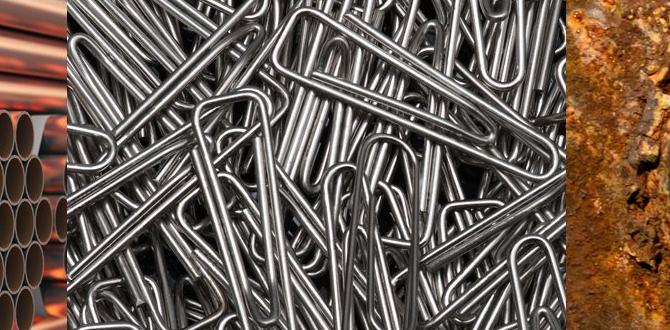Need to cut tough stainless steel with a small end mill? An 1/8″ extra long carbide end mill is your go-to for precise, clean dry cuts. Tackle challenging materials confidently with this essential tool designed for strength and longevity.
Hey there, machining enthusiasts! Daniel Bates from Lathe Hub here. Ever tried to machine stainless steel with a small end mill and ended up frustrated? It can feel like trying to carve granite with a butter knife. Stainless steel is tough stuff, and using the wrong tool can lead to broken bits, ruined workpieces, and a whole lot of wasted time. That’s where a specialized tool like the 1/8″ extra long carbide end mill designed for stainless steel really shines. It’s built to handle precisely these kinds of stubborn materials, even when you need to reach into tighter spots. We’re going to break down exactly why this specific end mill is such a powerhouse and how you can use it to get those clean, accurate cuts you’re aiming for, especially when dry cutting. Stick around, and we’ll get you cutting stainless steel like a pro!
Why 1/8″ Extra Long Carbide End Mills Are a Game-Changer for Stainless Steel
So, what makes a small, extra-long carbide end mill so special when it comes to stainless steel? It’s a combination of material, geometry, and design that’s perfect for this challenging application.
Carbide: The King of Hardness.
Carbide (specifically, tungsten carbide) is incredibly hard and can withstand higher temperatures than high-speed steel (HSS). Stainless steel is notoriously difficult to machine because it work-hardens rapidly and generates a lot of heat. Standard HSS cutters can dull quickly or even melt under these conditions. Carbide’s superior hardness and heat resistance mean it stays sharp longer and can handle the aggressive conditions of cutting steel.
1/8″ Diameter: Precision and Detail.
A 1/8″ (or 3mm, as it’s often standardized in metric) diameter is fantastic for detailed work. It allows you to mill small features, cut tight radii, and get into corners that larger end mills simply can’t reach. This is crucial for hobbyists and those working on intricate parts. It also means less material is being removed at any given moment, reducing the load on the machine and the cutter, which is beneficial when dealing with a tough material.
Extra Long Reach: Accessing the Inaccessible.
The “extra long” designation is key. This means the shank and effective cutting flute length are longer than standard end mills of the same diameter. Why is this important for stainless steel?
Deeper Slots and Pockets: If you need to mill a slot or pocket that’s deeper than a standard end mill can reach, the extra length is essential.
Reduced Tool Holders: Sometimes, using an extra-long end mill can eliminate the need for a long tool holder, which can add runout and vibration. By having the length intégrale on the end mill itself, you can potentially achieve a more stable cut.
Clearance: It provides clearance for workholding devices, clamps, or other features on your workpiece that might otherwise interfere with a shorter tool.
Designed for Stainless Steel:
While carbide is generally good, end mills specifically engineered for stainless steel often have special coatings (like TiAlN or AlTiN for extra heat and wear resistance) and a specific flute geometry (like 2 or 3 flutes for better chip clearance and strength, or a higher helix angle to help evacuate chips). The flute design is optimized to break chips effectively and prevent them from recutting, which is a major cause of tool failure in tough materials.
The Magic of Dry Cutting Stainless Steel
When we talk about “dry cutting” stainless steel with these specialized end mills, it’s important to understand why this is often preferred and how it works.
What is Dry Cutting?
Dry cutting, in this context, means machining without a liquid coolant flood. This doesn’t mean you’re running the tool completely dry and expecting it to survive. It refers to the absence of typical copious amounts of coolant often used in industrial settings. For small machines, hobbyists, or specific operations, managing a coolant system can be complex and messy.
Why Dry Cutting Works (Sometimes):
1. Material Properties: Modern carbide formulations and coatings are incredibly heat-resistant. They can handle the temperatures generated in dry cutting stainless steel, especially when combined with optimized feed rates and speeds.
2. Chip Evacuation: The end mill’s flute design is critical. Good chip evacuation prevents built-up edge (BUE) and the recutting of chips, which are primary causes of tool failure and heat buildup.
3. Controlled Heat: While heat is generated, the goal is to manage it. The heat will transfer into the workpiece and chips. If the chips are cleared quickly, the tool doesn’t sit in the hot zone for too long.
4. Simplicity: For home shops or smaller operations, avoiding coolant means less mess, simpler setup, and easier cleanup.
When is Dry Cutting NOT Ideal?
Very Deep Cuts or Heavy Material Removal: For very aggressive machining, especially in large quantities, coolant is still superior as it manages heat much more effectively, lengthens tool life, and improves surface finish.
Specific Stainless Steels: Some very gummy or difficult-to-machine grades of stainless steel might still strongly benefit from a mist coolant or a full flood if possible.
The Role of the 1/8″ Extra Long End Mill in Dry Cutting Stainless:
The small 1/8″ diameter means less friction and heat generation per pass compared to a larger tool. The extra long aspect might allow for fewer passes to reach a desired depth, potentially reducing overall machining time and therefore cumulative heat. The carbide material and specialized geometry are designed to dissipate heat effectively through chip evacuation.
Key Features to Look For in Your 1/8″ Extra Long End Mill
When you’re shopping for this specific tool, keep these crucial features in mind. They will make a significant difference in performance and longevity.
Number of Flutes:
2-Flute: Generally considered best for milling softer metals like aluminum and plastics, but also great for stainless steel when you need maximum chip clearance and strength. They have a larger chip gullet.
3-Flute: A good compromise for stainless steel. Offers more cutting edges for a potentially finer finish than a 2-flute, while still providing decent chip clearance.
4-Flute: Best for harder steels and general-purpose milling of softer materials like aluminum or plastics. For stainless steel, they tend to have less chip clearance and can be more prone to chip recutting if not used carefully.
Recommendation for Stainless Steel: Start with a 2-flute or 3-flute end mill for stainless. The enhanced chip evacuation is vital.
Helix Angle:
High Helix (e.g., 45° or 60°): These have a steeper spiral. They’re excellent for stainless steel because they shear the material more aggressively, leading to smaller chips that are easily evacuated from the flutes. This reduces heat buildup and prevents chip recutting.
Standard Helix (e.g., 30°): More common, good for general-purpose milling.
Recommendation for Stainless Steel: Look for a high helix angle (30° minimum, 45° or more is better).
Coatings:
Uncoated: Basic, can work for some applications but generally less effective for stainless steel.
TiN (Titanium Nitride): A gold-colored coating, offers some hardness and lubricity, but not ideal for the extreme heat of stainless steel.
TiCN (Titanium Carbonitride): Grayish, harder than TiN, better wear resistance.
TiAlN (Titanium Aluminum Nitride) / AlTiN (Aluminum Titanium Nitride): These are the workhorses for high-temperature alloys like stainless steel. They form a protective aluminum oxide layer at high temperatures, providing excellent thermal and oxidation resistance. They are typically dark gray or purplish.
Recommendation for Stainless Steel: TiAlN or AlTiN coating is highly recommended for its performance with stainless steel.
Material:
Solid Carbide: What you want. Offers the best hardness and heat resistance.
Shank Diameter:
1/8″ (3mm): For this specific tool. Ensure it fits your collet or tool holder.
Overall Length and Effective Cutting Length:
You need an extra long tool. Pay attention to the overall length and the length of the cutting flutes. Ensure it’s long enough for your specific application. A common length for an extra long 1/8″ might be around 2.5 to 4 inches total length, with a cutting flute length of perhaps 1 to 1.5 inches.
Setting Up Your Machine for Success
Before you even touch the stainless steel, a bit of preparation on your machine goes a long way. Think of this as setting the stage for happy machining.
1. Secure Workholding:
Vise: A good quality milling vise is usually essential. Ensure the jaws are clean and that you have solid, flat contact with your workpiece. Use soft jaws if you’re concerned about marring delicate surfaces.
Clamps: For larger or irregularly shaped parts, clamps might be necessary. Make sure they are robust, don’t obstruct tool travel, and are securely fastened.
Alignment: Ensure your workpiece is dead square and securely held. Any movement or shimmy will lead to poor cut quality and can break your end mill.
2. Rigidity is Key:
Minimize Z-axis Overhang: As much as possible, keep the cutting portion of the end mill close to the tool holder. The extra length is for reach, not for plunging excessively into the tool holder.
Spindle Vibration: Ensure your spindle bearings are good and there’s no excessive play. Any vibration will be amplified by the small, long tool.
Machine Bed Flatness: If you’re working directly on the mill table, ensure it’s clean and flat.
3. Tool Holder:
Collet Chucks: These offer the best runout for small diameter tools like 1/8″ end mills. Invest in a good quality ER collet chuck.
Balanced Tool Holders: For higher speeds, balanced tool holders are important, though for typical hobbyist speeds with this size tool, it might be less critical but still beneficial.
Step-by-Step Guide: Milling Stainless Steel with a 1/8″ Extra Long End Mill
Let’s get down to business! Follow these steps carefully for successful machining.
Step 1: Understand Your Machine’s Capabilities and Speeds/Feeds
This is critical. Stainless steel, especially with a small end mill, requires specific speeds and feeds to prevent tool breakage and ensure good results.
Surface Speed (SFM): This is the speed at which the cutting edge of the end mill is moving through the material. For stainless steel with carbide, a common range for dry cutting is 150-300 SFM (Surface Feet per Minute).
Spindle Speed (RPM): This is what your machine controls. You need to convert SFM to RPM using the formula:
RPM = (SFM 12) / (π Diameter)
Where:
RPM = Revolutions Per Minute
SFM = Surface Feet per Minute (e.g., 200 SFM)
12 = inches per foot
π (Pi) = 3.14159
Diameter = Diameter of the end mill in inches (0.125″ for 1/8″)
Example Calculation:
Let’s aim for 200 SFM with a 1/8″ (0.125″) carbide end mill:
RPM = (200 12) / (3.14159 0.125)
RPM = 2400 / 0.3927
RPM ≈ 6110 RPM
This shows you’ll likely need a spindle that can achieve higher RPMs. If your machine caps out at, say, 2000 RPM, you might need to adjust your SFM lower and accept slower cutting.
Feed Rate (IPM – Inches Per Minute): This is how fast the cutter is advanced into the material.
Feed Rate (IPM) = RPM Flute Count Chip Load
Chip Load: This is the thickness of the chip removed by each cutting edge. For a 1/8″ carbide end mill in stainless steel when dry cutting, a chip load might be very small, perhaps 0.001″ to 0.002″ per tooth.
Example Calculation:
Using our ~6110 RPM from above, with a 2-flute end mill and a chip load of 0.0015″:
IPM = 6110 2 0.0015
IPM ≈ 18.3 IPM
This is a very light feed rate. You will need to adjust based on your machine’s rigidity and your desired surface finish. Always start with conservative values and increase gradually.
Step 2: Program or Manually Set Your Toolpath
CAM Software: If you’re using a CNC machine, your CAM software will calculate these parameters for you. Ensure you input the correct tool diameter, number of flutes, material type, and desired speeds/feeds.
Manual Machining: For manual mills (like a Bridgeport), you’ll be controlling the handwheels to achieve the desired feed rate. This requires practice and a good feel for the machine.
Step 3: Set Up the End Mill in Your Machine
Cleanliness: Ensure the collet and the end mill shank are perfectly clean and free of any oil, chips, or debris.
Insertion: Insert the end mill into the collet chuck to the appropriate depth, usually about “one to one-and-a-half times the diameter.” For an extra long tool, this means ensuring enough of the shank is gripped securely.
Tighten: Tighten the collet securely and evenly.
Step 4: Perform a Dry Run
Clearance Check: With the spindle off, jog the machine through the entire toolpath to ensure the end mill doesn’t crash into clamps, vises, or other features of your setup.
Z-Axis Zero: Carefully set your Z-axis zero point. For plunge milling, you might want to do this by “touching off” with a piece of paper or using a probe.
Spindle-Off Dry Run: Lower the tool to just above the surface of your workpiece (or a test piece) and turn the spindle on without engaging the material. Listen for any strange noises or vibrations.
Step 5: Begin the Cut
Plunge Milling (if applicable): If you are plunging straight down into the material, do it slowly. Use a controlled feed rate. A common technique is to plunge at a shallow angle or into a pre-drilled hole if possible.
Engage Material: Start moving the end mill through the material at your programmed or calculated feed rate.
Listen and Observe: Pay close attention to the sound of the cut. A healthy cut sounds like a consistent, light “hiss” or “sizzle.” A squealing or chattering sound indicates you need to adjust speed, feed, or depth of cut.
Chip Evacuation: Watch the chips being produced. They should be small and consistent. If you’re seeing long, stringy chips, or if they’re not clearing the flutes, you may need to reduce the feed rate or increase peck depth if plunging.
Depth of Cut (DOC):
Radial Depth of Cut (Stepover): For a 1/8″ end mill, this is typically a small percentage of the diameter, from 20-50% for finishing passes, and up to 50-70% for roughing if your machine can handle it.
Axial Depth of Cut (Depth of Cut – DOC): For plunge milling, start with very shallow depths, perhaps 0.050″ to 0.100″ for a 1/8″ tool. For milling slots or pockets, you can often go deeper, but always err on the side of caution with stainless steel. A good starting point might be 0.100″ to 0.250″ for a 1/8″ tool, but you’ll need to adapt based on observation. You might need to do multiple passes to reach your final depth.
Step 6: Coolant (Optional but Recommended if Possible)
While we’re discussing dry cutting due to the tool’s capabilities, if you have the option, mist coolant or a small amount of cutting fluid applied manually can significantly improve results, extend tool life, and enhance surface finish. Apply it directly to the cutting area.
Step 7: Finishing
Once you’ve completed your roughing passes, you might want to do a finishing pass with a shallower depth of cut and a slightly higher feed rate (to get a better surface finish).
Withdraw the tool smoothly from the workpiece.
Step 8: Clean Up
* Remove the workpiece and clean your machine. Inspect the end mill and the workpiece for any signs of damage.
Table: Recommended Speeds and Feeds (Starting Points) for 1/8″ Carbide End Mill in Stainless Steel (Dry Cut)
This is a GUIDELINE. Always adjust based on your specific machine, coolant use (if any),








